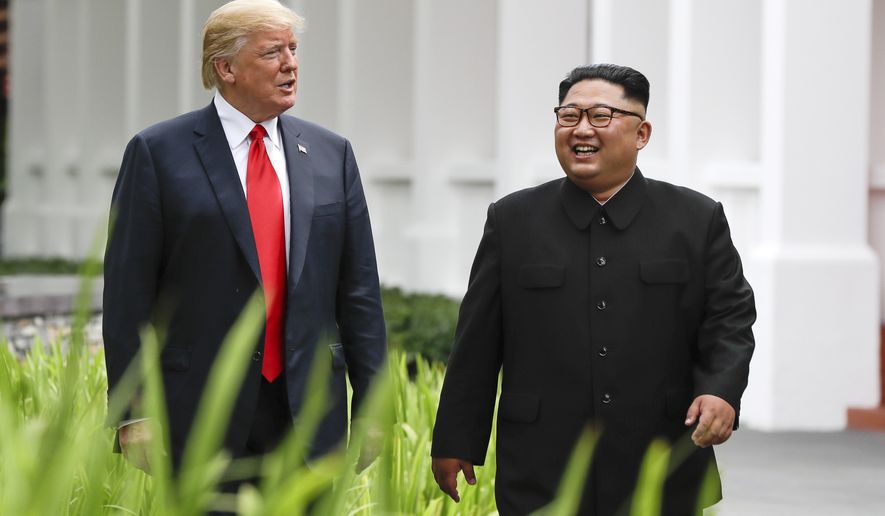OPINION:
Rome wasn’t built in a day, and neither will be a nuclear-free North Korea. Many critics complain that the results of the Singapore summit in 2018, where President Trump met North Korean leader Kim Jong-un and exchanged polite words, were written in disappearing ink. Many of those critics are saying the same thing this time about a summit in Hanoi. Peace is elusive and the search for it often tedious, but “jaw jaw,” as Churchill famously said, always beats “war, war.”
Mr. Trump himself is taking pains to temper expectations of the progress that he and his North Korean counterpart initiated at Singapore. “I’d just like to see, ultimately, denuclearization of North Korea,” he told an Oval Office press gaggle last week. “I think we will see that ultimately. I have no pressing time schedule. And I think a lot of people would like to see it go very quickly from the other side.” Additional meetings, he said, likely will be required before denuclearization of the Korean peninsula becomes reality.
The president has dropped his “rocket man” references since Mr. Kim suspended his provocative missiles tests last year, and is said to have shuttered a nuclear weapons production factory. The two leaders now have, says the president, “a good relationship.” “Good” is welcome, “productive” would be better.
Three thousand reporters from 40 countries are descending on Hanoi, which guarantees mostly an exchange of press gossip that can be committed to ink and electronic jaw, jaw. A carnival atmosphere has taken over the Communist capital, with hawkers peddling t-shirts bearing the likeness and name of “Rocket Man,” the insult ascribed to Mr. Kim by President Trump before they made up for their talks in Singapore. What North Korea wants most is a declaration of peace between Washington and Pyongyang after 70 years of bitter enmity born in the blood and ice of the Korean War. Such a formal end to seven decades of hostilities, however, would require the sanction of neighbors, including first South Korea and then of China.
Peace is the ultimate aspiration, but an end to the North’s ability to threaten U.S. cities with nuclear destruction is the immediate aim. Stephen Biegun, the president’s new adviser on North Korea, describes the first U.S. objective as a “complete understanding of the full extent of the North Korean weapons of mass destruction missile programs,” monitoring of its sites and eventually “the removal and destruction of stockpiles of fissile material, weapons, missiles, launchers, and other weapons of mass destruction.”
Denuclearization is hampered by Pyongyang’s long-standing suspicion of American intentions and the accurate American appraisal of Pyongyang’s record of disappointing behavior. Dan Coats, the director of National Intelligence, testified to Congress in January that “North Korea will seek to retain its weapons of mass destruction capabilities, and is unlikely to completely give up its nuclear weapons and production capabilities.”
Mindful of the North’s distrust, Mr. Trump wants to see interim steps, such as the disclosure and closure of several nuclear facilities. For his part, Mr. Kim can be expected to call for the lifting of economic sanctions that have hampered the isolated nation’s foreign trade and resulted in pleas to the international community for food. But until the nuclear risk is “substantially reduced,” says Secretary of State Mike Pompeo, expectations of sanctions relief is wishful thinking.
Even if the two leaders emerge from their discussions with little more than flowing signatures on a gauzy resolution of common aspirations, a small step would not necessarily be a failure. Ronald Reagan ended the Reykjavik Summit on a sour note in 1986, when he rejected Soviet President Mikhail Gorbachev’s entreaty to put the Strategic Defense Initiative on hold in exchange for a deal reducing intermediate-range nuclear weapons. The broken agreement became a strategic American victory a year later, when both parties returned to the bargaining table and eventually signed a sweeping pact. This led to a genuine detente and ultimately the end of the Soviet Union.
It may be more than a coincidence that, as Mr. Trump squares his shoulders to meet with his opposite number from North Korea, he is said to be close to closing a historic trade agreement with China after having met Chinese President Xi Jinping at Mar-a-Lago. Deals are up for grabs, and with his nation linking geographic giants China and Russia to economic powerhouses South Korea and Japan, Mr. Kim has an opportunity to seize a piece of prosperity.
With the eye of a billionaire businessman, Mr. Trump says he “really believes that North Korea can be a tremendous economic power when this is solved.” The next step is Mr. Kim’s, and it has to be a genuine next step.




Please read our comment policy before commenting.